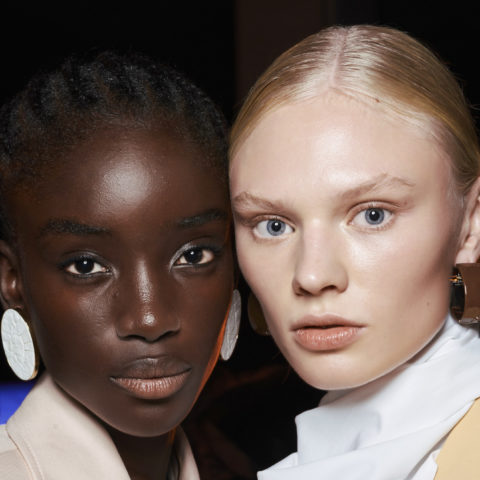Here’s Exactly What’s Going on With Your Skin Each Day of Your Menstrual Cycle
It’s a known fact that Chrissy Teigen does not hold back on Twitter, whether it’s clapping back at trolls, calling out racist paparazzo or slamming Donald Trump. But perhaps our fave Chrissy Teigen Twitter moments are when she gets real about her “curves and all her edges and her perfect imperfections,” like that time she proudly showed off her stretch marks.
And now, the 31-year-old model is proving she’s ~*totally relatable*~ and just like us in that she, too, experiences “period skin.”
— christine teigen (@chrissyteigen) July 31, 2017
Girl, we feel you.
“That time of the month” can be unpleasant enough without the addition of unwanted acne and yet it’s something that usually appears like clockwork. It’s frustrating, but it’s something we’ve come to accept as an inevitability. But why is it that these breakouts happen, and what’s causing our skin to feel like sandpaper one day and super oily the next? Other than the obvious umbrella answer of “hormones,” it’s time we understand what’s truly going on. What does it mean for our skin when those hormones peak or plummet and what can we do to counteract their negative effects on our skin? We spoke with dermatologist Dr. Dendy Engelman to help us understand what’s going on under the surface and how we can maintain our natural glow all cycle long. (Note: we’ve based this post on a 28-day cycle.)
To simplify: there are three main hormones that fluctuate during your cycle; estrogen, progesterone and testosterone. Dr. Engelman says that “estrogens affect skin thickness, wrinkle formation and skin moisture [which helps to] maintain fluid balance and structural integrity.” Estrogen has two major highs and lows in production during your cycle, which is the main cause for the massive swings in your skin’s appearance throughout those 28 days. A spike in progesterone at the end of your cycle is what “can cause breakouts by closing pores and causing sebum (a thick, oily substance) to build beneath the skin’s surface,” explains Dr. Engleman. This is when you should be diligent about keeping your face as clean and fresh as possible (no touching!). Lastly, testosterone, although it does not reach the peaks of the previous two, does rise during ovulation and contributes to a healthy glow.
We broke down the average menstrual cycle by day to get a better understanding of how these hormone surges affect our skin and how to switch up your skin routine to make sure you’re giving your skin everything it needs.
Day 1
This is the first day of your period and the first day of your cycle. All hormones are at an all-time low, meaning your skin will be dry and may appear dull. Make sure to use your heaviest moisturizer, drink lots of water and avoid the temptation of a hot shower, as the heat will further dehydrate your skin.
Days 2 – 6
Progesterone and testosterone remain low and estrogen begins a slow increase in production. No major changes to the skin will be noticeable. Don’t skimp on your morning and nightly routine, as your skin needs attention most during this time of your cycle. Treat yourself to your favourite facial peel to help brighten your complexion.
Days 7 – 9
Estrogen continues its climb and you will notice a slight improvement in your skin’s appearance.
Days 10 – 13
Estrogen is at an all-time high, and there’s also an increase in testosterone. Your skin should be at its best for appearance with a high retention of moisture. Use a regular or lightweight moisturizer during these days and embrace a bare-faced look. Your skin’s natural glow will be all you need to look your best. Time to go selfie crazy!
Day 14
Ovulation day. Your skin should still have a healthy glow.
Days 15 – 19
After ovulation, estrogen and testosterone start to decrease and progesterone begins to increase. You will notice your skin becomes slightly oilier at this point. Due to the surge in progesterone, your “skin swells and pores are compressed shut, as a result, pores never looked so minimized,” according to Dr. Engelman. Make sure you don’t fall asleep with makeup on during this time (not that you ever should) as this is the beginning of potential period breakouts. Also, due to the excess oil being produced use a lighter moisturizer during these days.
Days 20-24
Progesterone is at its peak and this is when menstrual-induced acne is most likely to occur. Dr. Engelman recommends using “products that keep pores open like salicylic acid, which also combats inflammation. Vitamin A derivatives like retinols and retinoids help to decrease sebum production and keep pores unclogged. Benzoyl peroxide containing products kill acne [bacteria] that can proliferate during hormonal fluctuations.” Avoid touching your face, make sure makeup brushes are clean and cleanse your face thoroughly every morning and night.
Days 25 – 28
Both estrogen and progesterone begin to plummet in preparation for Day 1. This is a good time to do a hydrating mask and pamper yourself as you begin to naturally lose your skin’s moisture.
Although we may never fully kick those nasty chin pimples so many of us are plagued with each month, at least we can arm ourselves (and bathroom shelf) with the proper products we should be using for different times of the month.








